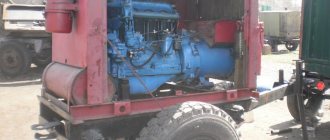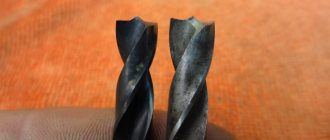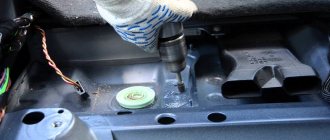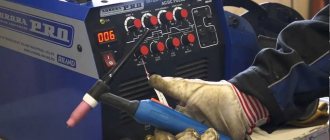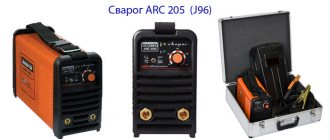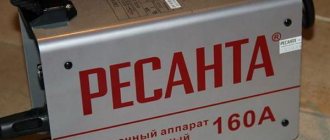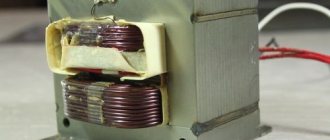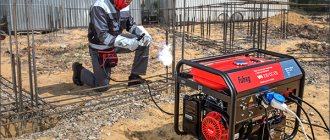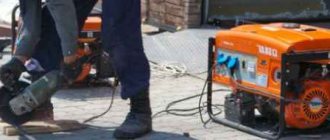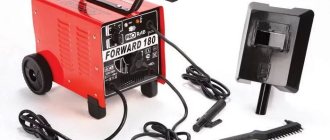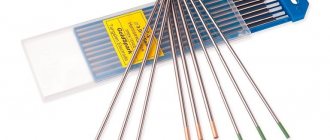Rating of spot welding machines
The adhesion of the materials is ensured by a seam consisting of many small welded points. To create them, the part is placed between two electrodes; they compress it from below and from above, while simultaneously passing current. There are two types of welding machines - portable and stationary. We conducted research on several dozen devices, evaluating each on a number of indicators:
- Category – household, industrial, professional;
- Type – pliers, portable apparatus, stationary machine;
- Welding method – single-sided, double-sided, combined version;
- Current – maximum indicator, equipment capabilities from 3000 to 10,000 A;
- Speed of work - how many hitch points are left per minute;
- Permissible thickness of materials - which sheets can be overlapped;
- Voltage – single-phase 220 V, three-phase 380 V;
- Control – ease of use, manual, synergistic (microprocessor) setting;
- Noise level – sound pressure in dB during active mode;
- Power – the parameter is measured in kW, the higher it is, the thicker the surface;
- Additional options – cooling system, equipment.
The demand for such devices has been growing over the years. Manufacturers are improving their products, adding new products to the market. We have selected products that have received the highest ratings from experts and the most favorable reviews from customers and ordinary owners. As a result, 7 nominees were identified - 4 ticks, 3 spotters.
Spot welding spotters
A spotter is a type of hand-held spot welding device, useful in the repair of transport equipment and at construction sites. It demonstrates greater efficiency when interacting with large products when access to the inside is impossible. Sold as a standard set - the device itself, grounding cable, power supply wire, welding gun. We analyzed the opinions of craftsmen, customer reviews, tested the most popular models, identifying 3 clear leaders.
Fubag TS 2600
Spotter for one-sided tack welding on metal products up to 1.5 mm thick. With compact dimensions of 200x320x180 mm, the device consumes a voltage of 5.4 kW, delivering a current of 2800 A. The kit is supplemented with a gun, a carbon electrode and three “stars”, a rod with a reverse hammer. There are several operating modes (5 in total) - heating with a carbon electrode, welding of corrugated wire and rings, tack with stars. Thanks to the reverse hammer and 1.1 kg weight, you can quickly pull out dents. The weight of the structure is 14 kg. The manufacturer provides all the necessary tools. Additional functions - thermal protection, ignition control.
Advantages:
- Reliable connection;
- Light indication;
- Complete set of tools;
- 5 modes;
- Easy to set up;
- Compactness.
Flaws:
- Difficult to move due to heavy weight;
- There is no option to adjust the current in amperes.
Consuming high voltage, the device is recommended to be used in the country, in the garage. The model was originally designed for auto body repair, straightening, and removing dents from steel surfaces by pulling, pulling, and straightening.
FoxWeld SW-2500
A semi-automatic transformer provides capacitor welding with a discharge time of 1 to 3 ms. The entire workflow is fully automated, so even a beginner can use the FoxWeld SW-2500. The penetration depth is the minimum possible - approximately 0.1 mm, this allows operations on thin-walled metals of 0.6 mm. At the same time, parts and products are not subject to perforation, deformation, or change color. The kit consists of a gun, a power source, a clamp-mass, collets and keys for changing them. The case measures 355x355x155 mm and weighs 14.5 kg. Power 2.5 kW, pin diameter should not be more than 10 mm. For ease of control, a digital display is installed on the front wall. The speed of formation of coupling points is 10-20 pieces per minute.
Advantages:
- High performance;
- Digital display;
- Wide scope of application;
- Nice kit;
- Accurate result;
- Easy to use.
Flaws:
- Cables cannot withstand low temperatures;
- Price.
According to the characteristics and declared capabilities, the device is classified as a professional category. Can work with steel, stainless steel, aluminum, brass. Used in building construction, instrument making, electronics industry, etc.
TCC SW-1600
Ultrasonic spot welding machine for coupling studs using the capacitor method. This is an instantaneous discharge of energy at a speed of 1-3 ms or 10-20 pieces per minute. The minimum thickness of the metal sheet should be 0.6 mm, without leaving any marks. Power consumption 1.6 kW. A digital display is provided for control. The package includes a power cable, a power supply, a gun on the wires, a ground clamp, collets and keys for replacing them. The manufacturer also provides a warranty. The degree of protection against moisture and dust here is higher than that of previous nominees - IP21. With dimensions of 355x355x155 mm, the structure weighs 18 kg.
Advantages:
- High precision ultrasound;
- Digital display;
- Performance;
- Speed;
- Nice kit;
- Professional series.
Flaws:
- Price;
- Not always available in stores.
You can use this device if you have to work with brass, steel, or aluminum. Its main difference is saving energy consumption and the owner’s time. This is a new product from a Russian manufacturer, created with modern technologies. Withstands both domestic and industrial loads.
The best pipe benders
Principle of operation
The physics of the process is elementary and is known even to a schoolchild. We all know that when electric current flows through a conductor, the conductor heats up. The greater the current, the greater the heating. In resistance spot welding, the parts being welded act as conductors. They are placed on top of each other, clamped with special electrodes and voltage is applied.
Since the resistance of this section is negligible, even at a voltage of several volts, currents of hundreds and thousands of amperes flow (depending on the capabilities of the power source). Currents of this magnitude bring the metal of the parts to strong heating and softening, which, with high pressure from the electrodes, creates conditions for mutual diffusion.
The task of the welding machine comes down to creating a sufficient force to compress the parts with the electrodes and supplying high currents at the time of welding the parts. It is also necessary to ensure effective cooling of the electrodes, otherwise they will simply melt, because the same current flows through them as through the parts being connected.
How to choose a spot welding machine
Not only price and financial capabilities decide which resistance welding machine to buy. Much depends on the goals, scope of application, as well as technical performance characteristics. We familiarized ourselves with the recommendations of experienced craftsmen, after which we identified the primary criteria - exposure mode, maximum possible welding current, metal thickness, control method, and power consumption.
Impact mode
Modern models operate in two modes of influence on workpieces and parts:
- One-way mode. It is more typical for spotters that are equipped with a gun with a rod, a reverse hammer with an electrode at the end. To weld, you need to grab this part to the surface and perform reverse blows to pull out the metal. This method is appropriate if the impact is carried out in hard-to-reach places, as well as when interacting with large products.
- Two-way mode. This method is appropriate if you need to overlap metal. Ticks that grip the area on both sides will cope with this task. The distance of the points will depend on the reach of the consoles, usually 12-50 cm. The upper console is movable; it is lowered by pressing while simultaneously heating.
Maximum welding current
The capabilities of the equipment directly depend on the welding current limit. For example, if the device produces 3000 A, the overall cross-section will be able to connect parts 3 mm thick. If the parameter is increased to 6000 A, then 4-5 mm steel is “stitched”. Such capabilities are demonstrated by household models; for industrial purposes, reinforced equipment of 10,000-16,000 A has been created, which corresponds to a total thickness of 9 mm.
Thickness of welded metals
This criterion also cannot be ignored when choosing welding equipment. If the instructions indicate that pliers or a spotter will grip sheets 3 mm thick, then work with wider surfaces will be of poor quality. The parameter is designated in two ways - total (for example, 6 mm) or separate (3+3 mm). Industrial versions are capable of simultaneously fastening 3 sheets, then the parameter will be 3+3+3 mm.
Control method
Everyday tasks can be easily solved by a simplified model with manual control. Budget products do not provide for adjusting the current strength, always operating at maximum. With pliers, the operator will need to independently squeeze the consoles, controlling the contact of the electrodes.
Modern, industrial designs are equipped with a synergistic microprocessor control method. For this purpose, a digital panel is provided, where the wizard indicates the type of connection and the thickness of the product. The smart system independently selects the optimal mode and turns on and off the current at the right time. All that remains is to bring the electrodes to the foot area.
Power
The power indicator is selected taking into account the surfaces that will be processed. Refractory metals require a device on which the current can be adjusted over a wide range. For ordinary metal, the standard spot welding option is suitable. A parameter within 5 kW will withstand single-phase voltage, everything above that requires additional measures or a 380 V network.
Safety precautions
Spot resistance welding is a relatively safe type of work and does not require special safety measures. At the same time, we should not forget that devices designed for this type of welding are connected to a high-voltage network and require compliance with all rules for operating in such networks.
A specific danger characteristic of this type of work is the splash of molten metal, which can be a consequence of welding in the wrong mode or poor cleaning of the surface of the parts being joined. To protect against this phenomenon, it is necessary to have a welder's mask. When welding galvanized metals that emit harmful gases, it is necessary to provide the work area with effective exhaust ventilation.
Which spot welding machine is better?
The welding machine must be reliable, productive, and as accurate as possible in performing its functions. All presented nominees meet these parameters, reviews confirm this. The recommendations of Vyborexperta.ru will tell you what to choose and buy based on a comparative analysis of the pros and cons of each position:
- Caliber SVA-1.5 AK is a budget compact model of Russian-made pliers;
- Telwin Digital Modular 230 – device with a timer for high-strength steel sheets;
- Blueweld Plus 230 – high power, left-handed/right-handed model, microcontroller;
- Fubag TS 2600 – compact spotter with 5 operating modes, light indication;
- TCC SW-1600 is the highest indicator of accuracy, speed, and efficiency.
The choice of such a welding device should be approached with complete seriousness. In order for the costs to be justified, all factors are taken into account in advance. Conventionally, the nominees can be divided into household and professional designs. Much depends on the frequency of use, level of load, personal needs, and which products will be repaired.
